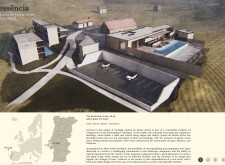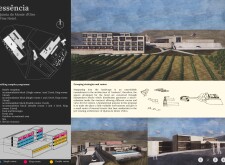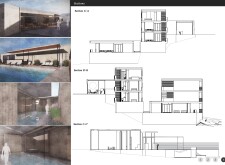5 key facts about this project
The project functions as a wine hotel, providing accommodations, dining options, and wellness facilities, all embedded within a setting that celebrates the local wine culture. Each component is arranged in distinct blocks that allow for independent yet interconnected use, fostering a sense of community while ensuring privacy for guests.
One of the key aspects of this project is its architectural layout, which emphasizes walkability and interaction with the surrounding vineyard. The design encourages exploration and allows guests to engage fully with the landscape. The various accommodation types are distributed strategically to enable uninterrupted views of the vineyards, enhancing the experience of being surrounded by wine production.
The materiality of the project is another defining factor. The use of light concrete for the exterior walls provides durability while maintaining a contemporary aesthetic. Terrazzo flooring in public spaces enhances durability and usability, while honey wood elements add warmth to the internal environment. Weathering steel is utilized for planters and louvers, creating an earthy connection to the surrounding landscape.
The integration of these materials with the architectural design reflects a sensitivity to the regional context. The project employs local resources and traditional craftsmanship, reinforcing the connection between the hotel and its agricultural heritage. This unique approach differentiates the Quinta do Monte d'Oiro Wine Hotel from conventional hospitality projects, which often overlook the importance of context in design.
The design also includes several specialized areas, such as dedicated event spaces that can accommodate both intimate gatherings and larger functions. The wellness facilities, situated amidst natural landscaping, are designed to enhance the guest experience, promoting relaxation and connection to the environment. The integration of outdoor recreational areas with a pool further enhances opportunities for relaxation and leisure.
Each of these features serves to create a cohesive experience that aligns with the architectural vision. The project successfully balances modern design with respect for the local context, making it a notable addition to the region.
For those interested in delving deeper into the architectural plans, architectural sections, and architectural designs of the Quinta do Monte d'Oiro Wine Hotel, an exploration of the project presentation is highly recommended. Understanding the architectural ideas behind this project provides valuable insights into contemporary hospitality design in agritourism contexts.


























